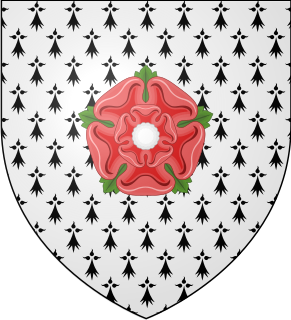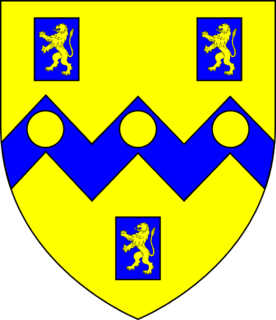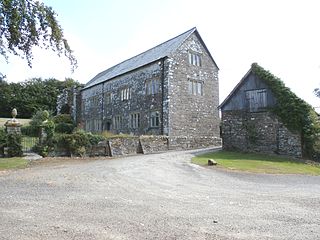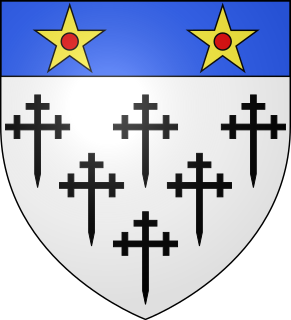
Samuel Rolle (1669-1735) of Hudscott, Chittlehampton, Devon, was MP for Barnstaple between 1705 and 1708. He was a member of a cadet branch of the influential Rolle family of Stevenstone.

Samuel Rolle (1669-1735) of Hudscott, Chittlehampton, Devon, was MP for Barnstaple between 1705 and 1708. He was a member of a cadet branch of the influential Rolle family of Stevenstone.
He was the son of Dennis Rolle (d.1671) of Great Torrington, a lawyer of the Inner Temple, son of Sir Samuel Rolle (d.1647), MP, one of three distinguished grandsons (his brothers were Henry Rolle (d.1656) Chief Justice of the King's Bench & John Rolle (d.1648), MP) of Henry Rolle of Heanton Satchville, Petrockstowe, 4th son of the founder of the Devonshire Rolles, George Rolle (d.1552), MP, of Stevenstone. [1] His elder brother was Robert Rolle (d.1660), MP, whose wife was Lady Arabella Clinton, co-heiress to the ancient Barony of Clinton.
He entered Exeter College, Oxford on 16 July 1687 and obtained the degree of BA in 1691. He trained as a lawyer in the Middle Temple which he entered in 1689 and was called to the bar in 1697.


He married Dorothy Lovering (d.1735), daughter and co-heiress of John Lovering of Hudscott, Chittlehampton, a merchant of Barnstaple, Devon. The marriage settlement is recorded as follows: [2]
"Indenture dated 27 April 1700, between Samuel Rolle, of the Middle Temple, London, Esq., of one part; Dorothy Lovering, eldest daughter and one of the coheirs of John Lovering, late of Hudscott, Co. Devon, Esq., 2nd part; Rt. Hon. Hugh Boscawen, of Tregothnan ; Samuel Rolle, of Heanton, Esq. (his first cousin Col. Samuel Rolle (1646-1719), MP, son of Robert Rolle of Heanton Satchville, Petrockstowe by his wife Lady Arabella Clinton); Nicholas Hooper, of Inner Temple, Esq. ; Joseph Bailer, (Venner?) Barnstaple, gent. ; Richard Parmynter, Barnstaple, merchant ; and Thomas Nott, of Mariansleigh, gent, 3rd part. Whereas a marriage is intended to be solemnized between said Samuel Rolle and Dorothy Lovering, etc. Trustees named are enfeoffed of various lands of Samuel Rolle, and also of lands of Dorothy Lovering, viz. Manor of St. Peter Hays, in parish of St. Thomas, lands granted to Elizabeth Bailer (sic, should be "Venner"), [3] mother of said Dorothy, for jointure, Higher Hudscott, Lower Hudscott, East Dennington, West Dennington, Lerwill, Row Park, Chappels Tenement, Whetstone, all in Chittlehampton ; Chuggaton, Brealey's Tenement and Smallridge's in Swymbridge ; messuages and closes in S. Molton, messuages in occupation of Richard Salisbury at Barnstaple; moiety of Huxhill Barton, Wear Giffard ; moiety of Manor of Countisbury, in parishes of Countisbury and Linton, with all its royalties, rights, members, and appurtenances; moiety of N. Furshill, Lynton; moiety Radspry, Linton; one quarter of Spiranger, Linton; moiety of tenement in East Ilkerton, in possession of Alexander Reed, Lynton; moiety of Manor of Curry Revel ; moiety of manor of Fivehead, and all other manors, lands, of Dorothy Lovering in Devon and Somerset in trust, etc., etc., etc. Children of marriage, etc."
John Lovering (d.1686) was the son of John Lovering (d.1675) a merchant of Weare Giffard by his wife Dorcas Doddridge, [4] sister and co-heiress of John Doddridge (d.1666), MP, of Bremridge, South Molton. John Lovering the son was also a merchant of Barnstaple, who in 1679/80 purchased from John Wichehalse of Ley (now Lee Abbey) in the parish of Lynmouth, and of Chard, the manors of Lynton and Countisbury. He is described in the conveyance indenture dated 24 May 1680 as of Weare Giffard. His residence there appears to have been at Huxhill Barton. [5] He married Elizabeth Venner the only surviving daughter of William Venner of Hudscott [6] who was the uncle of John Wichehalse. [7] He also purchased in 1645 from Adam Lugg of Barnstaple the manor of East Ilkerton and a moiety of Sparhanger, Radispray and North Fursehill. His two sons John Lovering and Venner Lovering predeceased him without children and he left two daughters as his co-heiresses, Dorothy Lovering, the wife of Samuel Rolle and Susanna Lovering, who married Richard Acland (1679-1729), MP, of Fremington House, Fremington, who succeeded Samuel Rolle as MP for Barnstaple. The large and grand red brick mansion of Fremington House displays two escutcheons showing the arms of Acland impaling Lovering. John Lovering appears to have been an exporter of herring fish to Spain, as the following recorded lawsuit of 1658 suggests: "John Martin v. John Lovering: Consignment of fish to St. Lucar or Seville in Spain. Touching a former suit also.: Devon; Spain". [8]
He is mentioned in the historical romance Lorna Doone (1869) by Richard Doddridge Blackmore as follows:
"And it is a very grievous thing, which touches small landowners, to see an ancient family day by day decaying: and when we heard that Ley Barton itself, and all the Manor of Lynton were under a heavy mortgage debt to John Lovering of Weare-Gifford, there was not much, in our little way, that we would not gladly do or suffer for the benefit of De Whichehalse".
Chanter (1906) states the account in Lorna Doone to be confused.
Hugh Boscawen (1625-1701), of Tregothnan, then MP for Cornwall, was the first cousin of Rolle's father, being the second son of Hugh Boscawen of Tregothnan by his wife Margaret Rolle, daughter of Robert Rolle (d.1633) of Heanton Satchville. [9] The Boscawen family was one of the richest and most influential in Cornwall, with extensive mining interests. He was the husband of Lady Margaret Clinton, the eldest of the two co-heiresses to the Barony of Clinton, the younger of which, Lady Arabella Clinton, had married Samuel Rolle's uncle Robert Rolle (d.1660), MP.
He had two daughters and two sons, one who predeceased him. Samuel Rolle (1704-1747), his only surviving son who died childless, bequeathed his estates including Hudscott and the Lovering moiety in Countisbury to his much wealthier cousin, Denys Rolle (1725-1797), MP, of Stevenstone, who sold all his Countisbury lands in parts and parcels chiefly to the occupying tenants, East Lynmouth being sold in 1759 to Peter Hooper, and the rest at various dates up to 1782. [10]
He died on 28 February 1735 and was buried at Chittlehampton, in which church exists a mural monument, on the west wall of the south transept, inscribed as follows:
"To the memory of Samuel Rolle, Esq., Dorothy his wife and Samuel Rolle Esq., their son, who died: Feb. 28th 1734 aged 66; Ap. 14th 1735 aged 60; March 1st 1746 aged 43. And whose lives have left to posterity a more expressive memorial than can be perpetuated on the most durable marble".
On the monument is shown an escutcheon with the arms of Rolle in the centre of which is an escutcheon of pretence with the arms of Lovering: Argent, on a fesse wavy azure a lion passant or, which signifies that Dorothy Lovering was an heiress.
The tomb was sculpted by Peter Scheemakers. [11]

Baron Clinton is a title in the Peerage of England. Created in 1298 for John de Clinton, it is the seventh-oldest barony in England.

Chittlehampton is a village and civil parish in the North Devon district of Devon, England. The parish is surrounded clockwise from the north by the parishes of Swimbridge, Filleigh, South Molton, Satterleigh and Warkleigh, High Bickington, Atherington, and Bishop's Tawton. According to the 2001 census, the parish had a population of 820. There is an electoral ward of the same name. In the 2011 census this ward had a population of 2,255.

John Rolle, 1st Baron Rolle was a British peer who served as a Member of Parliament in general support of William Pitt the Younger and was later an active member of the House of Lords. His violent attacks on Edmund Burke and Charles James Fox in the early 1780s led to his being the target for satirical attack in the Rolliad. He was colonel of the South Devon Militia and was instrumental in forming the Royal 1st Devon Yeomanry and the North Devon Yeomanry.
Callington was a rotten borough in Cornwall which returned two Members of Parliament to the House of Commons in the English and later British Parliament from 1585 to 1832, when it was abolished by the Reform Act 1832.

John Rolle (1598–1648) was a Turkey Merchant and also served as MP for the Rolle family's controlled borough of Callington, Cornwall, in 1626 and 1628 and for Truro, Cornwall, in 1640 for the Short Parliament and in November 1640 for the Long Parliament. He supported the Parliamentarian side in the English Civil War.

Sir Samuel Rolle of Heanton Satchville in the parish of Petrockstowe, Devon, served as Member of Parliament for Callington, Cornwall in 1640 and for Devon 1641–1647. He supported the parliamentary side in the Civil War.

Hugh Boscawen was an English politician who sat in the House of Commons on seven occasions between 1646 and 1701.

John II Dodderidge (1610–1659) of Bremridge in the parish of South Molton, Devon, was a lawyer who was elected MP for Barnstaple in 1646 and 1654, for Bristol in 1656 and for Devon also in 1656, and chose to sit for Devon, but was prevented by Oliver Cromwell from taking his seat.

Richard Fortescue of Filleigh, North Devon was an English Member of Parliament and prominent land-owner and member of the Devonshire gentry, ancestor to the Earls Fortescue.

Stevenstone is a former manor within the parish of St Giles in the Wood, near Great Torrington, North Devon. It was the chief seat of the Rolle family, one of the most influential and wealthy of Devon families, from c. 1524 until 1907. The Rolle estates as disclosed by the Return of Owners of Land, 1873 comprised 55,592 acres producing an annual gross income of £47,170, and formed the largest estate in Devon, followed by the Duke of Bedford's estate centred on Tavistock comprising 22,607 with an annual gross value of nearly £46,000.

George Rolle of Stevenstone in the parish of St Giles in the Wood near Great Torrington in Devon, was the founder of the wealthy, influential and widespread Rolle family of Devon, which according to the Return of Owners of Land, 1873 in the person of Hon. Mark Rolle, the adoptive heir of John Rolle, 1st Baron Rolle, had become by that year the largest landowner in Devon with about 55,000 acres. He was a Dorset-born London lawyer who in 1507 became Keeper of the Records of the Court of Common Pleas and was elected as a Member of Parliament for Barnstaple in 1542 and 1545. He became the steward of Dunkeswell Abbey in Devon, and following the Dissolution of the Monasteries he purchased much ex-monastic land in Devon. Not only was he the founder of his own great Devonshire landowning dynasty but he was also an ancestor of others almost as great, including the Acland baronets of Killerton, the Wrey Baronets of Tawstock and the Trefusis family of Trefusis in Cornwall now of Heanton Satchville, Huish, later Baron Clinton, heirs both of Rolle of Heanton Satchville, Petrockstowe and of Rolle of Stevenstone.

Margaret Rolle, 15th Baroness Clintonsuo jure, was a wealthy aristocratic Devonshire heiress, known both for eccentricity and her extramarital affairs.

Denys Rolle of Hudscott, Beam, Stevenstone and Bicton in Devon and East Tytherley in Hampshire, was an independent Member of Parliament for Barnstaple, Devon, between 1761 and 1774. He inherited a large number of estates and by the time of his death he was the largest landowner in Devon. He was a philanthropist and generous benefactor to charities and religious societies.

Hudscott is a historic estate within the parish and former manor of Chittlehampton, Devon. From 1700 it became a seat of a junior branch of the influential Rolle family of Heanton Satchville, Petrockstowe and in 1779 became a secondary seat of the senior Rolle family of Stevenstone, then the largest landowner in Devon. Hudscott House, classified in 1967 a Grade II* listed building, is situated one mile south-east of the village of Chittlehampton. It was largely rebuilt in the 17th century by the Lovering family and in the late 17th century became a refuge for ejected Presbyterial ministers. In 1737 its then occupant Samuel II Rolle (1703-1747) purchased the manor of Chittlehampton and thus Hudscott House became in effect the manor house of Chittlehampton.

Bremridge is a historic estate within the former hundred of South Molton in Devon, England. It is now within the parish of Filleigh but was formerly in that of South Molton. It is situated 8 miles north-west of South Molton. Since the construction of the nearby A361 North Devon Link Road direct access has been cut off from Bremridge to Filleigh and South Molton. The surviving wing of the mansion house built in 1654 is a Grade II* listed building. Bremridge Wood is the site of an Iron Age enclosure or hill fort, the earthwork of which is situated on a hillside forming a promontory above the River Bray. In Bremridge Wood survives a disused tunnel of the former Great Western Railway line between South Molton and Barnstaple, much of the course of which has been used for the A361. The tunnel is 319 yards long and was identified as "Bremridge Tunnel" in the 1889 Ordnance Survey map but as "Castle Hill Tunnel" in subsequent editions.

Hawkridge in the parish of Chittlehampton in North Devon, England, is an historic estate, anciently the seat of a junior branch of the Acland family which originated at nearby Acland, in the parish of Landkey and later achieved great wealth and prominence as the Acland Baronets of Killerton, near Exeter. The former mansion house is today a farmhouse known as Hawkridge Barton, a grade II* listed building. The Devon historian Hoskins (1959) stated of Hawkridge: "Externally there is nothing remarkable except a decaying avenue of ancient walnuts, so often the first indication of a 16th or 17th century mansion". The interior contains a fine plaster heraldic overmantel showing the arms of Acland impaling Tremayne, representing the 1615 marriage of Baldwin Acland (1593–1659) of Hawkridge and Elizabeth Tremayne.

William Rolle was Member of Parliament for Callington in Cornwall in 1604 and 1614.

Clinton Devon Estates is a land management and property development company which manages the Devonshire estates belonging to Baron Clinton, the largest private landowner in Devon. Lord Clinton is of the Fane-Trefusis family, and is seated at Heanton Satchville in the parish of Huish, in Devon. The organisation's headquarters are situated on part of the estate at the "Rolle Estate Office" in the Bicton Arena at East Budleigh, near Budleigh Salterton, East Devon.
The Manor of Bicton is an historic manor in the parish of Bicton in east Devon, England.

Hugh Fortescue, 1st Earl Clinton, 14th Baron Clinton of Castle Hill in the parish of Filleigh, and of Weare Giffard Hall, both in North Devon, and of Ebrington Manor in Gloucestershire, was a landowner and peer. He built the surviving Palladian stately home of Castle Hill.